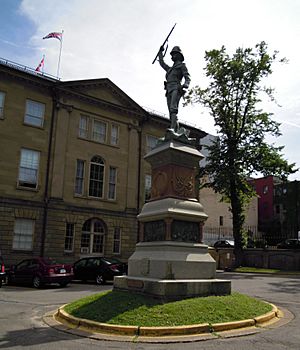South African War Memorial (Halifax) facts for kids

Boer War Monument, Province House
|
|
| Coordinates | 44°38′53.86″N 063°34′24.65″W / 44.6482944°N 63.5735139°W |
|---|---|
| Location | Halifax, Nova Scotia, Canada |
| Designer | Hamilton MacCarthy |
| Type | War memorial |
| Opening date | 1901 |
| Dedicated to | Those who fought in the Boer War |
The South African War Memorial is a special monument in Halifax, Canada. You can find it in the courtyard of Province House, which is an important building in Nova Scotia. This memorial honors the brave soldiers who fought in the Boer War.
Contents
Building the Memorial
The monument's history began on October 19, 1901. On that day, the Prince of Wales visited Halifax. He was the future King George V of the United Kingdom. The Prince helped lay the first stone for the monument. This was a very special visit, as it was the first time a Prince and Princess of Wales had come to Canada. The Prince also gave medals to soldiers returning from the war.
Just two weeks later, on November 1, soldiers who were heroes from the Battle of Paardeberg marched through George Street. They were celebrated for their bravery.
The Artist and the Details
A talented artist named Hamilton MacCarthy created this statue. He also made other important monuments. These include the Boer War Monument in the Halifax Public Gardens. He also created the statue of Harold Lothrop Borden in Canning.
The base of the monument has four detailed panels. Each panel tells a part of the war story. One panel shows troops leaving Halifax to go to South Africa. Another panel shows the Battle of Witpoort. This battle was important because Harold Lothrop Borden, a famous Canadian soldier, was lost there. A third panel shows the Battle of Paardeberg. This was Canada's most important battle in the war, with many soldiers involved. The last panel shows the Siege of Mafeking. These panels also honor the three main groups of Canadian soldiers: the infantry (foot soldiers), mounted rifles (soldiers on horseback), and artillery (soldiers who used cannons). Two Nova Scotia regiments, The Princess Louise Fusiliers and the Nova Scotia Highlanders, took part in the war.
Remembering the Soldiers
For about 20 years after the war, Canadians would gather on February 27. This day was known as "Paardeberg Day." People would meet at war memorials to pray and honor the veterans. This tradition continued until the end of the First World War. After that, a new day of remembrance, Remembrance Day, began on November 11.
Gallery
-
Battle of Witpoort, Boer War Monument, Province House, Nova Scotia
Honored Officers
The monument lists the names of several officers who bravely served and were lost during the war. Here are some of them:
- Major Harold Lothrop Borden (son of Frederick William Borden), King's Canadian Hussars
- Lieutenant Charles Carroll Wood (son of John Taylor Wood), Royal North Lancashire Regt.
- Lieutenant Barclay Webster (son of Barclay Webster), K.O.B.L.R.
- Captain John Halliburton Laurie (son of John Laurie Sr.), Royal Lancaster Regt.
- Lieutenant Monson Goudge Blanchard, 5th Regt, Canadian Artillery
- Captain Charles Albert Hensley, Royal Dublin Fusiliers
- Sergeant John E. Pemberton
- Sergeant John R. Margeson R.C.R.
- Corporal Harvey (Harry) Butler B. Williston





